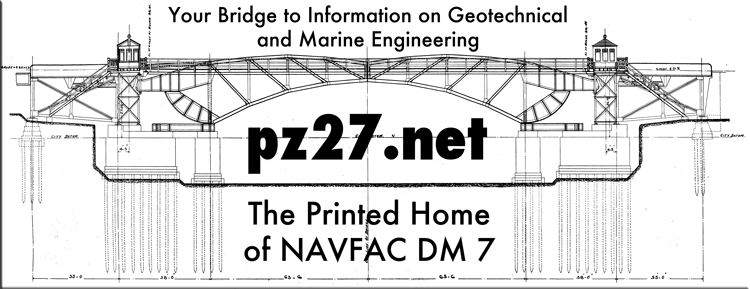Corrosion/Degradation of Soil
Reinforcements for Mechanically Stabilized Earth Walls and Reinforced Soil Slopes
Note: we also have an earlier version of this, FHWA-NHI-00-044, Corrosion/Degradation of Soil Reinforcements for Mechanically Stabilized Earth Walls and Reinforced Soil Slopes
Victor Elias, P.E., Kenneth L. Fishman, Ph.D., P.E., Barry R. Christopher, Ph.D., P.E. and Ryan R. Berg, P.E.
FHWA-NHI-09-087
November 2009
This manual provides criteria for evaluating corrosion losses when using coated or uncoated steel reinforcements, and for determining ageing and installation damage losses when using geosynthetic reinforcements. Monitoring methods for in-situ corrosion rates for steel reinforcements are evaluated and remote methods using electrochemical methods are recommended. Monitoring methods for determinations of in-situ ageing of geosynthetics are evaluated and protocols for implementation are recommended.
Design and Construction of Mechanically Stabilized Earth (MSE) Walls
Thomas P. Taylor, Ph.D., P.E.; James G. Collin, Ph.D., P.E.; Stan Boyle, Ph.D., P.E.; Ken Fishman, Ph.D., P.E.; Jie Han, Ph.D., P.E.
Dan Brown and Associates
FHWA-HIF-24-002 (FHWA Geotechnical Engineering Circular #11)
August 2023
We also offer its predecessor documents:
- FHWA-NHI-00-043, Mechanically Stabilized Earth Walls and Reinforced Soil Slopes Design and Construction Guidelines (Allowable Stress Design (ASD) Procedures
- FHWA-NHI-10-024 and FHWA-NHI-10-025, Design of Mechanically Stabilized Earth Walls and Reinforced Soil Slopes (Load and Resistance Factor Design (LRFD) Procedures, Volumes 1 and 2 (one file))
This manual is the reference text used for the FHWA NHI courses No. 132042 and 132043 on Mechanically Stabilized Earth Walls and Reinforced Soil Slopes and reflects current practice for the design, construction and monitoring of these structures. This manual was prepared to enable the engineer to identify and evaluate potential applications of MSE walls and RSS as an alternative to other construction methods and as a means to solve construction problems. The scope is sufficiently broad to be of value for specifications specialists, construction and contracting personnel responsible for construction inspection, development of material specifications and contracting methods. With the aid of this text, the engineer should be able to properly select, design, specify, monitor and contract for the construction of MSE walls and RSS embankments. The MSE wall design within this manual is based upon Load and Resistance Factor Design (LRFD) procedures.
Development of the Simplified Method for Internal Stability
Design of Mechanically Stabilized Earth Walls
Tony Allen, Barry Christopher, Victor Elias, Jerry DeMaggio
Washington State Department of Transportation
WA-RD 513.1
July 2001
In 1994, a technical working group under the auspices of the T-15 Technical Committee on Substructures and Walls of the American Association of State Highway and Transportation Officials (AASHTO) Bridge Subcommittee, was formed to re-evaluate the design specifications for mechanically stabilized earth (MSE) walls contained in the AASHTO Standard Specifications for Highway Bridges (1996). One of the areas of focus was the internal stability design of MSE walls. Several methods for calculating the backfill reinforcement loads were available at that time in the AASHTO Standard Specifications, and the intent was to unify the design methods to simplify and clarify the specifications. To accomplish this, full-scale MSE wall case history data were gathered and analyzed so that the unified method developed could be calibrated to the empirical data, since all of the methods available were empirical in nature. The effect of simplifications in the method, such as how vertical soil stresses are calculated and how reinforcement stiffness is considered in the design, could also be evaluated with these full-scale wall data to ensure that the unified method developed was adequately accurate. From this effort, the AASHTO Simplified Method was developed.
This report summarizes the development of the Simplified Method. It uses a number of full-scale MSE wall case histories to compare the prediction accuracy of the Simplified Method to that of the other methods currently available and focuses primarily on steel reinforced MSE walls. The theoretical assumptions used by the Simplified Method, as well as the other methods, are also evaluated and compared in light of the empirical evidence. This evaluation showed that the prediction accuracy of the Simplified Method is at least as good as that of the other methods, while the Simplified Method still simplifies calculations. This evaluation also showed, however, that all of the methods have limitations that must be considered.
Limit Equilibrium Design Framework for MSE Structures with Extensible Reinforcement
FHWA-HIF-17-004
October 2016
Current design of reinforced soil structures in the U.S. distinguishes between slopes and walls using the batter angle as a criterion. Using a unified approach in limit state design of reinforced ‘walls’ and ‘slopes’ should diminish confusion while enabling a wide and consistent usage in solving geotechnical problems such as complex geometries and soil profiles. Limit equilibrium (LE) analysis has been used successfully in the design of complex and critical (e.g., tall dams) for many decades. Limit state analysis, including LE, assumes that the design strength of the soil is mobilized. Presented is a LE framework, limited to extensible reinforcement, which enables the designer to find the tensile force distribution in each layer required at a limit state. This approach is restricted to Allowable Stress Design
(ASD). Three example problems are presented.
Mechanically Stabilised Earth Wall Inspector’s Handbook
Paul D. Passe, P.E.
Florida Department of Transportation
This manual is primarily intended for the inspector of mechanically stabilised earth retaining walls. However, it contains a great deal of information of general interest concerning the construction and configuration of these walls.

There is an update to GEC-11:
“Geotechnical Engineering Circular No. 11 – Design and Construction of Mechanically Stabilized Earth (MSE) Walls “
Publications – Geotech – Bridges & Structures – Federal Highway Administration (dot.gov)
LikeLike
Thanks for bringing this to my attention. I’ve downloaded it and will update the site.
LikeLike